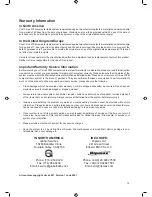
(Range Check Procedure - Engine Powered Car)
Install fully charged batteries (either dry or rechargeable) in the model. Switch on the transmitter, then the
receiver. Follow the engine starting procedure. Ideally, have a friend hold the model or place it on a stand where
the drive wheels cannot come into contact with the ground. Leaving the transmitter’s aerial fully retracted, move
approximately 10m (30 feet) from the model. Now, check that the movement of each servo responds to transmitter
inputs for both steering and throttle.
Note 1: If the servos do not follow the commands from the transmitter or any type of interference is
detected, DO NOT operate the model. Check that all batteries are fully charged and ensure that nobody else
is operating on your radio’s frequency.
Note 2: Before use, fully extend the transmitter’s aerial or operating range will be reduced and control
could/will be lost.
RUNNING SAFETY PRECAUTIONS
Important!
• Always switch ‘ON’ your transmitter first, followed by the receiver. Always switch ‘OFF’ your receiver first,
followed by the transmitter. Failure to follow these procedures could result in a runaway model with the
possibility of damage to property and/or injury to yourself and/or others.
• Do not try to operate two or more models on the same frequency at the same time as this will cause
interference and loss of control of both/all models. AM, FM and PCM are all different methods of frequency
modulation. However, the same frequency cannot be used at the same point in time, regardless of
modulation type.
• Never operate your model in the rain or run it in water / through puddles or in mud. The transmitter,
receiver, most servos and most electronic speed controllers are
NOT
waterproof and contact with moisture,
immersion in water and/or snow will cause them to fail with resultant loss of control of your model. Should
any type of moisture enter any part of your radio system, stop using it immediately and return it to the
specified service centre for inspection/repair.
• Do not operate your model within 1.6Km (1 Mile) of another sight where radio control activity commonly
occurs. Interference from other radio systems operating on the same frequency as yours could/will result in
loss of control and possible injury to yourself and/or others, as well as possible damage to property.
• Do not operate your model where visibility is limited. Should you lose sight of your model a collision could
occur that may damage property and/or injure someone.
• Do not operate your model near people or next to/on public roads. Prior to the operation of your model
ensure that the area that you intend to operate in is safe to do so. Be aware of any objects that may obstruct
the operation of your model. Do not operate your model where people and/or other moveable objects may
stray into its path. Loss of control due to radio interference, component failure, obstructed sight or low
battery voltage could result in damage to property/the model and/or injury to yourself and/or others.
• When installing in an electric model, attach the receiver to the chassis or mounting plate with thick
double-sided tape. When installing in an engine powered model, wrap the receiver in foam rubber or a
similar padded material. Protect from water damage by securing in a plastic/rubber bag and/or placing
in a waterproof radio box. The receiver is made from precision electronic parts which can be harmed by
vibration, shock and/or moisture. Take every precaution to protect against these factors.
Never
store your Cirrus R/C system where it could be exposed to the following conditions:
• Extremes of heat or cold
• Direct sunlight
• High humidity environments
• High vibration environments
• Dusty environments
11

































